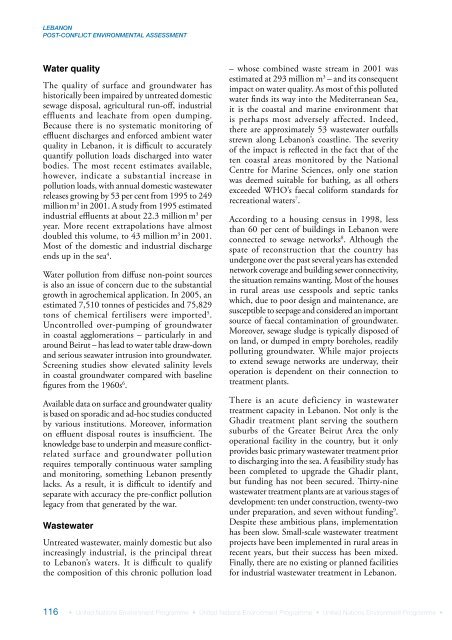Lebanon Post-Conflict Environmental Assessment - UNEP
Lebanon Post-Conflict Environmental Assessment - UNEP
Lebanon Post-Conflict Environmental Assessment - UNEP
Create successful ePaper yourself
Turn your PDF publications into a flip-book with our unique Google optimized e-Paper software.
LEBANONPOST-CONFLICT ENVIRONMENTAL ASSESSMENTWater qualityThe quality of surface and groundwater hashistorically been impaired by untreated domesticsewage disposal, agricultural run-off, industrialeffluents and leachate from open dumping.Because there is no systematic monitoring ofeffluent discharges and enforced ambient waterquality in <strong>Lebanon</strong>, it is difficult to accuratelyquantify pollution loads discharged into waterbodies. The most recent estimates available,however, indicate a substantial increase inpollution loads, with annual domestic wastewaterreleases growing by 53 per cent from 1995 to 249millionm 3 in 2001. A study from 1995 estimatedindustrial effluents at about 22.3 million m 3 peryear. More recent extrapolations have almostdoubled this volume, to 43 million m 3 in 2001.Most of the domestic and industrial dischargeends up in the sea 4 .Water pollution from diffuse non-point sourcesis also an issue of concern due to the substantialgrowth in agrochemical application. In 2005, anestimated 7,510 tonnes of pesticides and 75,829tons of chemical fertilisers were imported 5 .Uncontrolled over-pumping of groundwaterin coastal agglomerations – particularly in andaround Beirut – has lead to water table draw-downand serious seawater intrusion into groundwater.Screening studies show elevated salinity levelsin coastal groundwater compared with baselinefigures from the 1960s 6 .Available data on surface and groundwater qualityis based on sporadic and ad-hoc studies conductedby various institutions. Moreover, informationon effluent disposal routes is insufficient. Theknowledge base to underpin and measure conflictrelatedsurface and groundwater pollutionrequires temporally continuous water samplingand monitoring, something <strong>Lebanon</strong> presentlylacks. As a result, it is difficult to identify andseparate with accuracy the pre-conflict pollutionlegacy from that generated by the war.WastewaterUntreated wastewater, mainly domestic but alsoincreasingly industrial, is the principal threatto <strong>Lebanon</strong>’s waters. It is difficult to qualifythe composition of this chronic pollution load– whose combined waste stream in 2001 wasestimated at 293 million m 3 – and its consequentimpact on water quality. As most of this pollutedwater finds its way into the Mediterranean Sea,it is the coastal and marine environment thatis perhaps most adversely affected. Indeed,there are approximately 53 wastewater outfallsstrewn along <strong>Lebanon</strong>’s coastline. The severityof the impact is reflected in the fact that of theten coastal areas monitored by the NationalCentre for Marine Sciences, only one stationwas deemed suitable for bathing, as all othersexceeded WHO’s faecal coliform standards forrecreational waters 7 .According to a housing census in 1998, lessthan 60 per cent of buildings in <strong>Lebanon</strong> wereconnected to sewage networks 8 . Although thespate of reconstruction that the country hasundergone over the past several years has extendednetwork coverage and building sewer connectivity,the situation remains wanting. Most of the housesin rural areas use cesspools and septic tankswhich, due to poor design and maintenance, aresusceptible to seepage and considered an importantsource of faecal contamination of groundwater.Moreover, sewage sludge is typically disposed ofon land, or dumped in empty boreholes, readilypolluting groundwater. While major projectsto extend sewage networks are underway, theiroperation is dependent on their connection totreatment plants.There is an acute deficiency in wastewatertreatment capacity in <strong>Lebanon</strong>. Not only is theGhadir treatment plant serving the southernsuburbs of the Greater Beirut Area the onlyoperational facility in the country, but it onlyprovides basic primary wastewater treatment priorto discharging into the sea. A feasibility study hasbeen completed to upgrade the Ghadir plant,but funding has not been secured. Thirty-ninewastewater treatment plants are at various stages ofdevelopment: ten under construction, twenty-twounder preparation, and seven without funding 9 .Despite these ambitious plans, implementationhas been slow. Small-scale wastewater treatmentprojects have been implemented in rural areas inrecent years, but their success has been mixed.Finally, there are no existing or planned facilitiesfor industrial wastewater treatment in <strong>Lebanon</strong>.116 • United Nations Environment Programme • United Nations Environment Programme • United Nations Environment Programme •
















